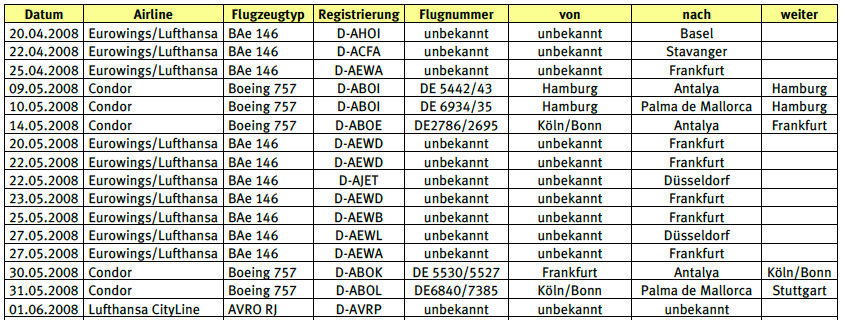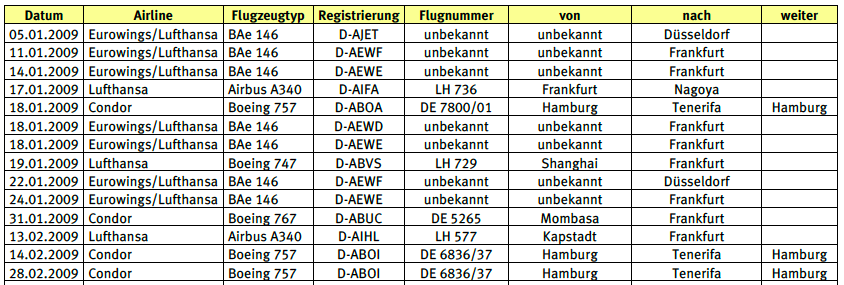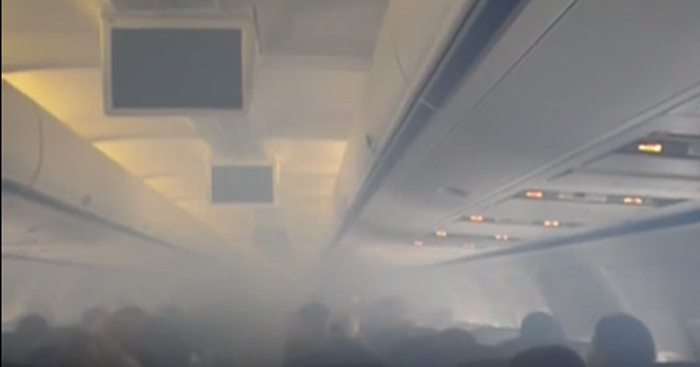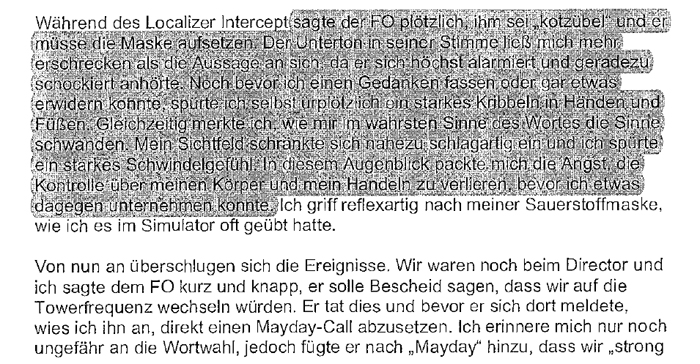
"Incidents": Incidents that do not usually appear in official statistics
There is no comprehensive overview of all occurrences (smell events, fume events): there is no continuous obligation to report for the airlines. If the cabin air is laced with nerve toxins or other chemical substances, this is at best an incident; an incident, not an accident. "Incidents" are events that can be repeated - from the point of view of the supervisory authorities.
Even 'major' incidents authorities are not always made aware of and/or, not about the real extent of it. Thus, one of the most serious "incidents’“ which occured on December 19. 2010 on a Germanwings aircraft approaching Cologne/Bonn airport is only known because - subsequently – it was added to the incident list, because the case was talked about in the Tourism Committee of the German Bundestag ; in a non-public meeting. The captain and his co-pilot had given the airline a detailed report. But they did not pass that report on. This incident has been documented under the date in question further down this page.
So there is no clear picture of what really happend. One can only guess; for example, if affected crew members report to the employer's liability insurance association. In 2016, around 1,000 such incidents’ were received. Which means: on average of 3 per day. According to Lufthansa data however, this only occurs in 1 out of 2000 flights; meaning: 500 per year, or, on a statistical average 1.4 incidents’ daily. And that’s calculated without adding other airlines.
We therefore have to assume that the actual situation is (considerably) worse than the absolutely incomplete figures that are sometimes mentioned here or there. We have therefore summarised some incidents’, resp. data, as far as we have the knowledge. We want to document how incomplete the official statistics are. And what has to change urgently. As a first step.
Here is the absolutely incomplete list:
we begin with the year 2006
2006
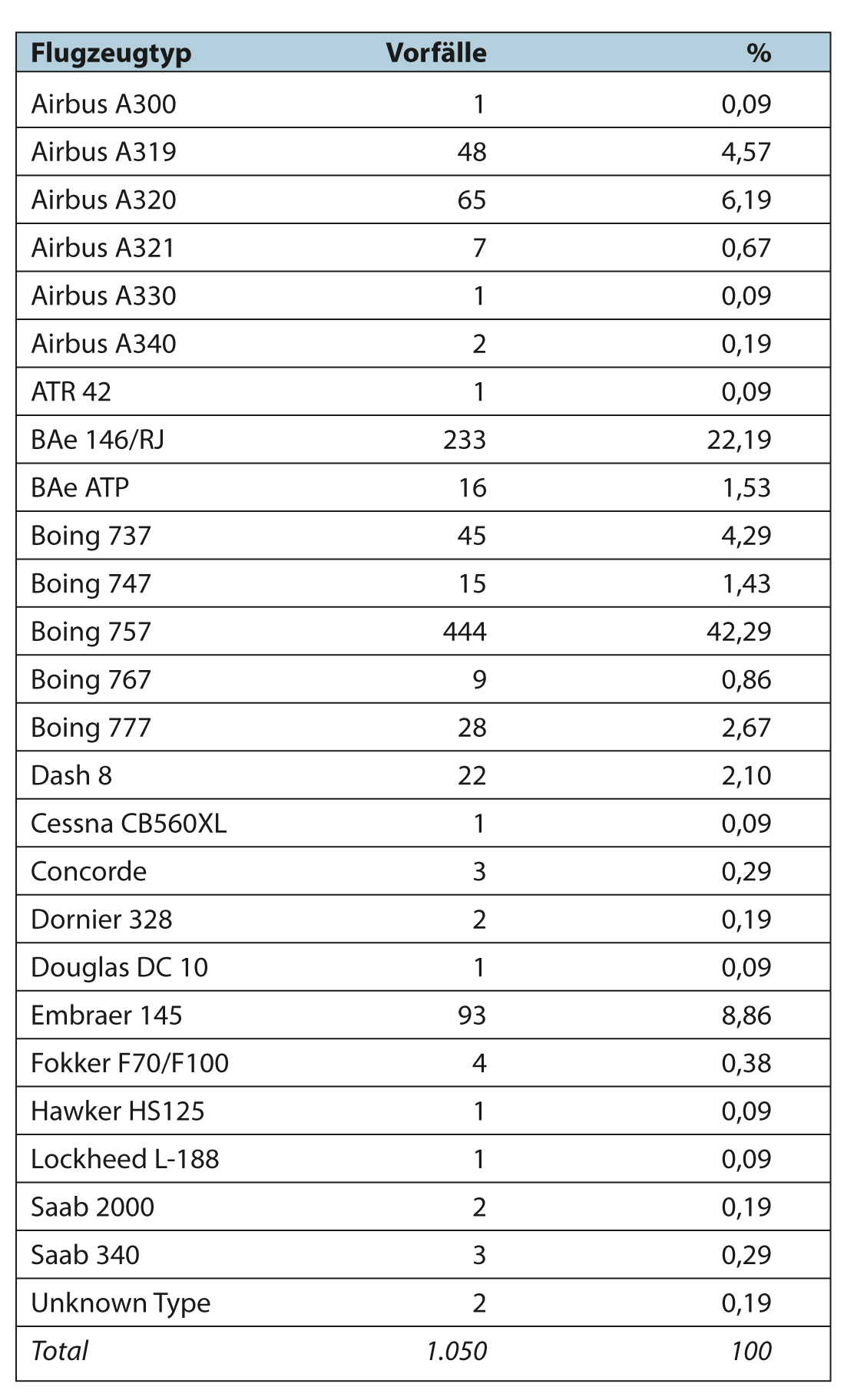
There are specific figures for fume events by type of aircraft listed by the British Civil Aviation Administration (CAA) .
These are based on a publication by former pilot Susan MICHAELIS in her dissertation about contaminated cabin air: "Health and Flight Safety Implications from Exposure to Contaminated Air in Aircraft" (University of New South Wales, Australia).
During her time as a pilot, MICHAELIS had to repeatedly deal with contaminated cabin air and since then has been working on the topic scientifically and in an advisory capacity.
But even this list is not likely to be complete. The dark figure is probably huge. There are experts who assume that only about 10% of such incidents’ are reported to the authorities.
2008
Research carried out by WDR counts for the year 2008 a total of 121 incidents
(Clicking the table opens the list as pdf):
11 of these fume events concern one single pilot: Sandy VERMEER, who is on-line for the Lufthansa subsidiary Cityline. The fact that there are only 11 so-called incidents’ is due to the fact that Sandy VERMEER was declared unfit-to-fly by the Lufthansa flight medic in November. VERMEER suffers from the consequences of the Aerotoxic Syndrome. In his 16 years of service, he has encountered around 50 fume events. Now, he is sick - for the rest of his life (more here: Affected by contaminated cabin air).
Of the total of 121 researched fume events, which may not be complete at all, the BFU records 56 "disturbances (cabin air)". Meaning: daily 1 event. In actual fact there’s twice as many.
No matter: not one of them has been reported by the BFU to the European Aviation Safety Agency (EASA), so not a single incident has been entered in the central European Coordination Center for Aircraft Incident Reporting System (ECCAIRS).
Only the Luftfahrt-Bundesamt (LBA) has reported numbers: a total of 10.
These official data emerge from the answer of the Federal Government to a request of the GREEN delegate Markus TRESSEL: BT printed matter 18/3949 v. Chr. 4.2.2015, there p. 2 and 3
2009
In the following year WDR identifies 71 incidents
(Clicking the table opens the list as PDF):
Renewed comparison of numbers:
- The BFU lists 53 "cabin air" fault reports,
- thereof 3 are reported to the EASA / ECCAIRS
- Reported by the LBA to EASA / ECCAIRS: also 3
This official data is also taken from the German Government's response to a request by the GREEN’s party member Markus TRESSEL (see below).
So far the numbers. Here are some incidents known about in the media:
16.10.2010
US Airways - Boeing 767
Charlotte / USA
Crew leaves the aircraft by ambulance. Reason: the crew complains of headaches and nausea, which is probably due to contaminated cabin air. According to the crew, it suddenly smelled of smelly socks. In addition to the crew, eight passengers need medical attention at the airport.
According to another report both pilots and 13 passengers and crew had to be transported from the plane on stretchers.
14.09.2010
Lufthansa Airbus A380
Frankfurt → Tokyo
Strong smell streams from the vents. The pilots are gradually switching off the bleed air supply. This allows the faulty unit to be identified and replaced.
October 2010
It happens on the flight from Phoenix (USA) to Maui in the Pacific Ocean. Smoke appears in the cabin on US Airways flight 432. No fire. Only a fume event. But a fierce one. Since the aircraft has traveled less than half the distance, they turn around heading for the nearest airport in the San Francisco area. The passengers have to hold out for a full 2 hours while the fire alarm sounds. One of the passengers decides to film these scenes on his mobile phone before landing. That’s how long the shock had prevented him from doing so.
19.12.2010
German Wings A319-132
Cologne / Bonn Airport
On this day, one of the most dangerous incidents of this kind happens - at least, as far as others have not (yet) become known. Although this incident was reported to the BFU, it was initially not reported as an "incident". An investigation has not been initiated. This happened later: when this incident was brought up in the German Bundestag.
These are the events:
Already in descent to Cologne/Bonn and about 20 km before landing
the captain (35) and his copilot (26) noticed a strange smell, a mixture of burning and electricity. The captain thinks about donning his oxygen mask, but rejects the thought - the "smell event" seems to be decreasing.
However: Now the co-pilot tells the captain that he is feeling really sick. And he puts on his mask.
Just then, the captain's hands and feet begin to tingle, his field of vision narrows and his senses fade - all the while the Airbus 319 continues to descend. Now panic is spreading. The captain launches a ‚mayday’ call, hoping they'll make the landing. After all, there are 142 passengers in the Airbus. The jet is in the mean time overhead of the Cologne city area:
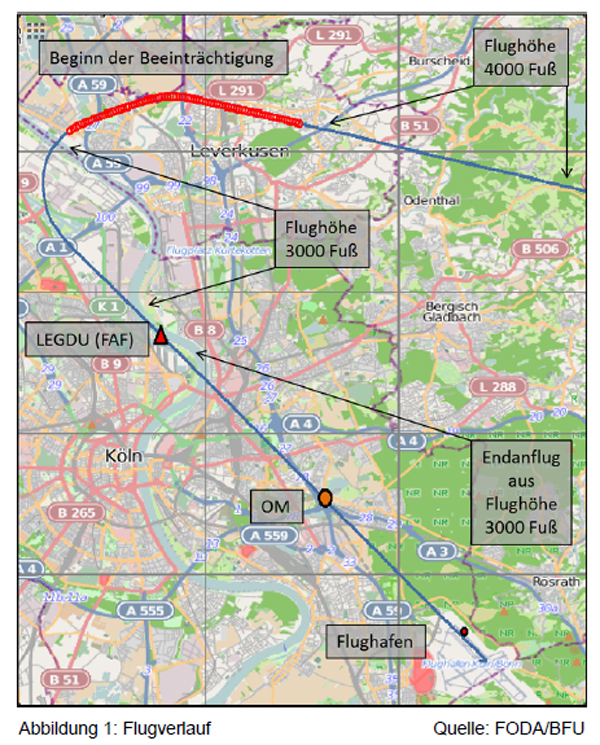
In a first reconstruction, which will only be carried out one year later (see below), the procedures in the cockpit read like this:
"At the time, the copilot had difficulty grasping the process in an overall picture, he was having trouble concentrating on individual aspects of what was happening and felt he could no longer digest the information.
Even the captain had arrived at the end of his capacity. He felt distracted by the noise of his own breath sounding in the oxygen mask and found this to be disturbing the communication between himself and his copilot. During the entire approach, he felt physically very ill.
With the manual flight flying commando (flight director), he worked at the upper limit of what he felt possible."
What the two pilots themselves write in their flight report and how they could still get the Airbus on ground, albeit with a mighty bang, reads like this: you can find a small excerpt in the picture; click on the text to open the two complete reports as pdf:
Still, they landed. A fire brigade squad and ambulances are already waiting on the runway. Captain and copilot must go to the hospital. The captain can fly again four days later, but the copilot will be "not fit to fly" for 6 months.
The employers professional insurance association (BG) registers the incident as an ‚incident’ - the airline reports it, because the copilot is unfit to fly for half a year. So the Lufthansa subsidiary Germanwings, who must pay him from their own budget for the first weeks, wants the money from their insurer "BG" for the time after that.
German BFU receives the news of the incident via fax from the police.
The further processing of this near-accident is reveiling:
It does not get underway until almost one year later in September 2011, when Tim van BEVEREN addresses this case at a hearing in the Tourism Committee of the Bundestag. This committee’s meetings are not public. Now, at least some members of parliament learn that the airlines and also the responsible BFU (German Federal Aircraft Accident Investigation Bureau) do not take the reports too seriously
The BFU will produce 2 reports:
- In the interim report, the reason is said to be "most likely due to deicing fluid; oil, fuel or electrical odors were definitely excluded by the technicians." The representative of the Federal Office for Civil Aviation, who will be present at the Tourism Committee one year later, will describe this statement - appropriately - as "nonsense": an airplane that has been in the air for more than an hour and is approaching an airport has no residues of deicing fluid left anywhere.
- However, for the final report the BFU has to make a little more of an effort. They leave the assessment up to the Air Force’s Aviation Medical Institute.
The reported symptoms could be, without further knowledge of the general situation, consistent with the inhibition of the enzyme acetylcholinesterase or other neurospecific esterases, which may be caused by organophosphate compounds, in particular tricresyl phosphate and its isomers. (P. 32). So: Aerotoxic Syndrome.However, from a differential diagnostical point of view, other causes could also be considered, which the BFU ultimately summarizes as follows:
"The cockpit crew’s health impairments that occurred during the approach, combined with a significant reduction in the performance of both pilots, were most likely due to the following cause: a massive development of smells in the cockpit area, of which the source and location could not be determined, may have contributed to: physiological and psychological effects of the odours on both crewmembers."
In other words: The copilot had exhausted himself with sports activities before the flight, the captain then succumbed to the so-called nocebo effect. The latter states (as opposed to the placebo effect) that health impairments can come about by imagining them.
Incidentally, the nocebo effect also largely explains the Aerotoxic Syndrome in English WIKIPEDIA. More: The presentation of the problem of contaminated cabin air in WIKIPEDIA
31.01.2013
Transavia - Boeing 737 800 - flight HV 6146
from Spain to Holland
During the flight there will be a fume event. The stewardesses are badly restricted in their work. Joanne de BOTT has severe ill-health issues since the flight.
23.03.2013
Condor - Boeing 757 - flight 5944
Hamburg → Las Palmas/Gran Canaria
Just before landing, stewardess Freya von der ROPP and her colleague notice a strange smell in the cabin. The smell becomes more and more intense and both stewardesses complain of headaches, nausea and feel numbed. In addition to the two women, the co-pilot feels so bad that he has to put on his oxygen mask. The plane lands safely in Las Palmas.
23.06.2013
Lufthansa - Airbus A 321
Frankfurt → Munich
Fume event during landing approach. At an altitude of between 2,500 and 1,500 meters, the cockpit and cabin crew notice a pungent odor.
A flight attendant is treated with symptoms of intoxication. From this day on she will be incapacitated for several months. In 2014, she will file a lawsuit against BG Verkehr: she wants the incident to be recognized as an occupational accident - the fume event took place in her workplace.
A lawsuit before the Hamburg Social Court takes forever. Especially if it’s against BG, who is financed by the aviation business.
On May 23, two years after the fume event, a result: BG Verkehr recognizes the occupational accident in connection with toxic cabin air. However, within an ‘agreement’ and on a ‘voluntary’ basis. Therefore, there is no ruling that others could cite as a precedent.
This is a strategy in the industry: avoiding attention and precedents, but offering hush money. Those affected usually have no choice if they do not want to be involved in years of costly legal battles. This could be anything but conducive o their health/ ill-health.
→ no ID at the BFU
12.07.2013
Alaska Airlines - Flight 769
The Alaska Airline plane emergency lands in Chicago. Four cabin crew members need medical care. Reason: fumes in the cabin. One of them is Vanessa Woods. Two years after the incident, she and two other flight attendants complain of tremors, memory problems and neurological problems. Reasons why they can not go about their profession.
All four sue Boeing and hold the aircraft manufacturer responsible for exposing passengers and crew to toxic fumes.
20.09.2013
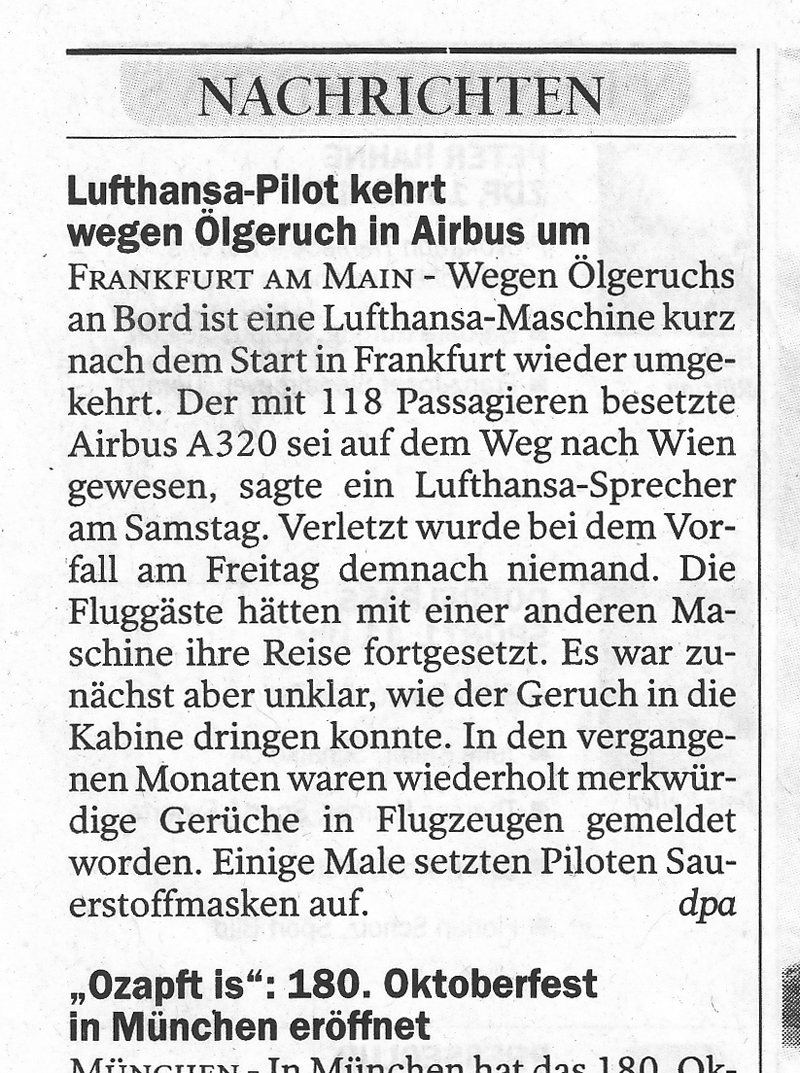
Lufthansa - Airbus A320
Frankfurt → Vienna
The aircraft returns shortly after take-off to Frankfurt. Reason: an unpleasant smell. The 118 passengers continue their flight in another aircraft. None of the passengers or crew members is injured. Due to that, if there was any news item in the media, it was more of a casual nature. As if one has already gotten used to it.
→ no ID at the BFU
12.08.2014
Boeing 767-300
London
Soon after take-off, the pilot decides to return to Heathrow. Reason: strong smell in the airplane. The pilot declares technical problems as a reason, because he does not want to give the passengers accurate information about the incident.
13.08.2014
Airbus A320
Prague / Ruzyne
Fumes in the flight deck cause discomfort to the flight crew. Both crew members put on an oxygen mask for safety's sake. The cabin crew complains about burning eyes and irritated nasal mucous membranes and a metallic taste in the mouth. The crew members are examined in a hospital.
02.11.2014
Boeing 777-200
Strong gas-like smell in the cabin near a door area. A passenger complains of a headache. Also, two crew members complain of nausea and another about severe headaches.
29.02.2015
Boeing 747
During the flight, the head flight attendant informs the captain that some of the cabin crew are feeling unwell. A flight attendant collapses and needs to be given oxygen. Overall, eleven crew members feel unwell during the flight and suffer headaches and nausea.
April 2015
Airbus A320
Hamburg → Dublin → stopover in Frankfurt
One of the students from our editorial team experiences a "fume event". However, at the time he is not aware of ‘aerotoxic syndrome’. He learns about it half a year later, as this topic is on the agenda of ansTageslicht.de. He subsequently writes a memory protocol: "An Aerotoxic Syndrome incident on a Lufthansa flight in April 2015?"
Abstract:
"So the voices of the passengers grew louder and louder, children started screaming and crying and I was getting more and more restless, too."
→ no ID at the BFU
19.04.2015
Airbus A321
There are fumes on board during the flight. The crew suffers from headaches, burning eyes and they feel weak. One crew member needs to be treated with oxygen.
16.06.2015
Flight EZY 1827
Manchester → Tel Aviv
Stopover with 181 passengers board in Berlin Schönefeld. Reason: three people, including one child, complain of nausea during the flight. Assumption: leakage of toxic gases. After landing, all 175 passengers and six crewmembers arefor tested ‘carbon monoxide’ poisoning. The test shows positive for 3 passengers, however, the hospital does not confirm the suspicion of poisoning.
The airport fire brigade cannot detect increased carbon monoxide levels on board.
→ no report to BFU
16.09.2016
Lufthansa Airbus 321-200
Frankfurt / M. - Dubrovnik
During landing approach to the destination airport a fume event occurs. The first officer (copilot) informs his captain that he suddenly finds himself unable to continue the landing approach. The captain takes over and lands the plane safely. Both go to a local hospital, both do not feel able to conduct the return flight.
The engineering team in Dubrovnik discovered traces of oil in the bleed lines of engine 1 and the auxiliary turbine (APU). As a first measure, the two bleed air supply lines are shut down and the aircraft is approved to return to Frankfurt / M as a ferry flight (without passengers). Apparently, because the Technical Logbook (TLB) was manipulated and the contamination of engine 2 was concealed - Lufthansa wants the plane quickly back in Frankfurt.
Another fume event happens during descent and landing approach to the home airport. The two replacement pilots switch off the bleed air supply via engine 2 and activate the emergency supply via RAM Air. This in turn leads to a drop in cabin pressure (no passengers), but helps improve the situation in the cockpit.
The incident is reflected in a closed forum on Facebook as follows; we omit the names, and explanations are in brackets:
___________________________________________________________________________________
"So I did not find out until I asked ***** when we would request a flight together for November. He says no can do, that he is unfit to fly and does not know how long for.
He then called me. Seemingly they were on approach to Dubrovnik and his FO (first officer) ***** ***** as PF (pilot flying) said during approach, he was not feeling so good, he should take good care of him. Turning base it was very bad and the bad smell was perceived.
When they landed, they refused to fly back. OZ (Lufthansa Operations Center) wanted to get the plane back to FRA (Frankfurt). Even the ‘clown’ (fleet boss) called.
But ***** refused. Apart from that, the FO was still feeling dizzy. The company then had to fly in technicians. That did not suit them as you can imagine. They then went straight to the hospital in DBV and got 30ml of blood drawn for further tests in FRA.
Important - it must be blood … they wanted to spin it to serum. They then took the blood back and chilled it. As you can immediately notice, all the doctors on the list we have, work with the company! DO NOT go! Luckily, they had a P1 (Purserette), who after six weeks of being unfit to fly after a (guess what?) bad smell (fume event), on her their first flight! But luckily for the rest of the crew, she was fit and knew what to do. This is important - as I said 30ml blood must be drawn within 4hours! Otherwise you can no longer prove anything. The medical service in FRA has been happy to let crews wait 4.5 hours ... without words. They are all in cahoots with one another.
Anyway, the next day, OZ calls if they would agree to fly the plane back to FRA, the technicians who had flown in from FRA had repaired it. ***** said yes, if he feels ok.
So they drive to the airport and get the briefing - ***** was fortunately also present- from the technicians. ENG1 bleed inop set by Technique for traces of oil found and Auxiliary Power Unit (Bleed Air) set in-op due to traces of oil found. Is what it says in the TLB, and the technicians said you could fly that way. No mention of NO ENG2! Everything was fine. So nothing was noted in the TLB (Technical Log book)!!! The company knew they would not have flown otherwise. They had made that clear on the phone. (Not only ENG 1 but also ENG2 and the APU were affected by oil contamination).
When they were on approach to FRA, they again smelled an odour and responded immediately - ENG2 bleed off (engine immediately issued) and Ram AIR on. The ears cracked, but at least the smell was gone.
So two smell incidents’ with the (same) plane. By pure chance, ***** looks on the same day in to the online TLB (there is a paper version that must remain in the plane, a statutory document, and the online version of it), which was not accessible to him in DBV. He could barely believe his eyes what was written about the repair in DBV:
ENG1 traces of oil found
APU traces of oil found AND
ENG2 traces of oil found!
The company has purposely covered up, together with the engineers, ENG2, so that the plane is returned to FRA! A huge mess! Luckily they had photographed the TLB and all paperwork, because the P1 had already said, that last time (at her first event) many things strangely disappeared ... End of the song, ***** has filed a case against the company at the LBA (Luftfahrtbundesamt).
The entire crew is unfit to fly. All have pulmonary function of around 80% or less and it is still not clear, if they have long-term damage. Even *****, who only wanted to accompany the crew and still thought he was fine, is also affected.
Should you ever have an incident, ***** gave me good tips.
Immediately put masks on and leave them on for 20 to 30 min AFTER the event. This helps the lungs enormously to avert long-term damage, the doctors said.
Secure evidence. Photograph everything, every chip of paper. You never know what it's good for.
- draw 30ml blood within 4hours.
It's best to go immediately to the hospital ‘Heilig-Geist’ after landing in FRA or with the samples already taken. They also do everything for the employer’s professional insurance association, so that one does not sit on one’s expenses and report the incident. They are really fit in their field. After that, they will send you to the University of Göttingen anyway. They leave space available for aviators. So you get an appointment right away."
30.09.2016
German Wings: 4U 8460
Berlin-Tegel - London Heathrow
A fume event which occurs right after off-blocks and push-back from the gate. The aircraft is not ordered back, but takes off. What the communication between Germanwings and the cockpit looks like is not known. Only that the aircraft is ordered to fly to Hamburg instead - there an aircraft is waiting to take-off to London. Obviously, there are economic reasons that force the issue.
So the incident is reported:
__________________________________________________________________________________
"At push back, 3L (flight attendant door rear left) and 3R (rear door right) were experiencing heavy hydraulic and exhaust fumes that were immediately reported to the cockpit.
The "fresh air intake" was increased according to an affected person in such a way, that it was reasonably ok again.
Take-off.
The odors recurred very quickly and were again reported by the colleagues at the rear of the aircraft.
Also, that both colleagues in the rear felt very bad very fast with severe symptoms occurring.
Symptoms:
Disorientation, tingling, numbness, one of the two had totally blurred vision, both had nausea, headaches, dizziness, balance disorders, an FA (flight attendant) vomited and collapsed after unbuckling from his crew seat.
Oxygen was administered to both colleagues (via oxygen cylinder / no use of smoke hood).
After an emergency landing in HAM, both colleagues were picked up by the ambulance and driven to hospital.
Both are, until further notice, ‘AU’ (unfit for work).
A flight attendant and the first officer went to HAM airport ER to the doctor, whether they are also AU is not known.
The CPT and Purser drove straight back to Berlin.
There is no knowledge as to the TLB entry (technical log book)."
15.10.2016
German Wings - Airbus A319-100
Flight 4U-2734 - registration D-AKNK
Stuttgart → Krakow
During the flight a stench that resembles old socks and smelly fish develops in the front of the cabin - as so often happens.
All flight attendants and at least one passenger feel unwell and complain of symptoms such as headache, nausea, palpitations, difficulty concentrating and extreme tiredness. In addition, some have a bitter taste in their mouth, others suffer from impaired consciousness and they feel faint. A flight attendant has to interrupt his work and is supplied with oxygen in the cockpit.
70 minutes later, the plane lands safely in Krakow. The entire crews as well as the passenger are medically examined. At least 2 flight attendants will be unable to fly until the end of January.
How this "accident" (not "incident") is perceived by other pilots and flight attendants and how it is discussed can be read on the Aviation Herald platfrom. In the case of the BFU, as usual, the occurrence is not registered:
→ no report at the BFU
25.10.2016
British Airways - A380 - Flight BA286
San Francisco → London → Landing in Vancouver
Due to 25 crewmembers feeling sick on the flight from San Francisco to London, they make an emergency landing in Vancouver. All 25 crewmembers, including the three pilots, are taken to hospital. Two passengers were medically examined on board and declared healthy.
Part of the crew showed symptoms such as red eyes, dizziness, headache, disorientation, memory loss, and a metallic taste in the mouth. The three pilots and the crew on the upper deck of the aircraft donned their oxygen masks. A report states that parts of the crew were "completely out of it " and "disoriented".
The pilot informs the passengers that there are technical problems and for this reason the aircraft is landing in Vancouver.
After landing, the plane is checked. The technicians cannot find any defects. The plane is later flown back to London without passengers.
Passenger Liz Keller reports that the first hours of the flight were completely normal. But then the pilot announced the emergency landing. Liz Keller then notices that the crew are worried. Cabin service was stopped.
Keller also complains that she and the other passengers hardly got information about he emergency landing. Passengers receive a hotel room and a telephone number to rebook the flight.
05.11.2016
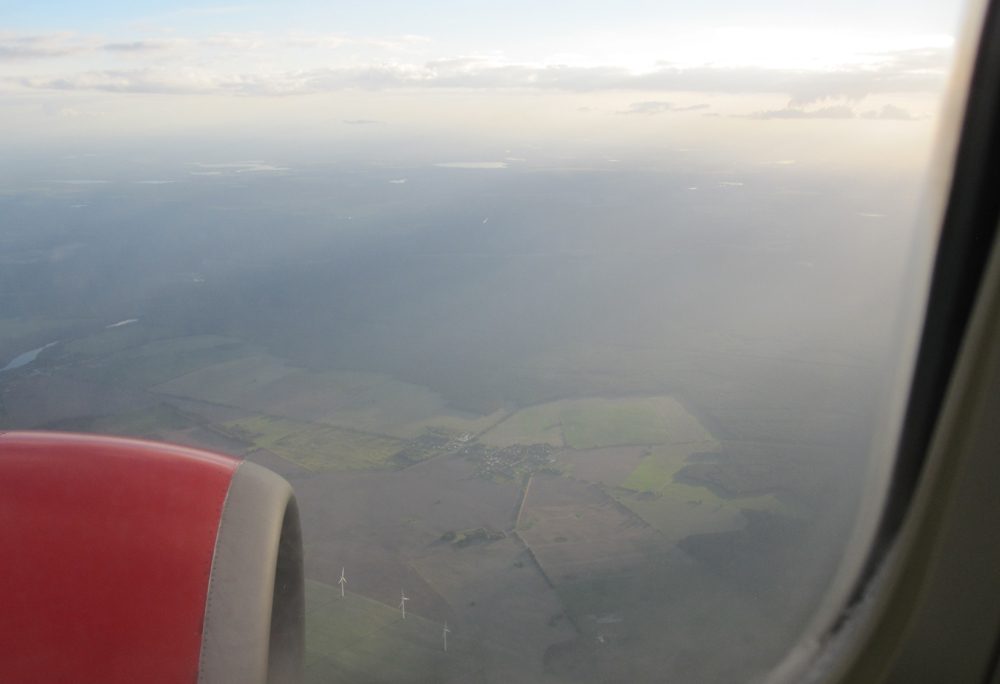
The Austrian independent aviation magazine Austrian Wings deals with the problem of fume events and similar incidents’ not always being reported to the responsible authorities, at least not in Germany:
BFU: Of "accidents" and "serious disturbances" that must not be
Journalistic inquiries regarding specific incidents’ are quickly and briefly swept aside with the same standard answers as follows, which Austrian Wings has (very) often heard:
"As you are probably aware, the legal basis of the work of the Federal Bureau of Aircraft Accident Investigation (BFU) is the European Union Regulation, EU Regulation 996/2010 and the Aircraft Accident Investigation Act, FLUUG from 1998, as well as ICAO Annex 13. According to the BFU It is not a serious incident or an aircraft accident, so there will be no investigation by the BFU on these reported events."
2017
Incidents that have occurred since January 1st, 2017, but also other information about events that are related to it, are documented in our
Aero-Toxic Log Book in ENGLISH: www.ansTageslicht.de/ENATLB
Miscellaneous
To reiterate: not all airlines report such incidents to the relevant authorities. Passengers hardly ever do it. Therefore, the official statistics are more than incomplete. Whatever finds its way to the media is even more rare. Therefore, the incidents’ listed here as "disturbances" (BFU) can only convey a fragmentary impression of the regular occurrence of this problem.
If you would like to have an overview of passed and current smell and fume events, you can get that at: Aviation Herald
Also Tim van BEVEREN informs regularly on his Facebook blog: www.facebook.com/tvbeveren and the former Lufthansa cabin manager Bearnairdine BEAUMONT on her facebook page: www.facebook.com/aerotoxicsyndrome
A daily documentation of ‘breakdowns’, incidents and accidents worldwide, not just cabin air disturbances, is available at Aviation Herald. This is a completely independent platform that is well networked within aviation and can draw on many informants and whistleblowers and therefore has a wide overview of problems, breakdowns, incidents and accidents. And does not mince the words: http://avherald.com.
She same applies to the platforms www.aeroinside.com and http://airflightdisaster.com. Here too, incidents and accidents of all kinds are reported.
If you yourself experience such an incident, you should inform not only (or at least) one of the three mentioned platforms, but also for example, an official body within the aviation authorities. Addresses and links can be found at: What can you do (in English: forthcoming!).
Online am: 28.11.2017
Aktualisiert am: 11.12.2017
Inhalt:
- Fume Events Worldwide
- What is different when we fly at 10 km altitude?
- Contaminated cabin air: a health problem becomes certainty. The chronology of the socalled Aerotoxic Syndrome
- "Incidents": Incidents that do not usually appear in official statistics
- Lufthansa’s subsidiary ‚Germanwings’: December 19, 2010
- Health, Science and Economic interests in Aerotoxic Syndrome
- An UNCOVERING of Tricks, Methods and Strategies, how to downplay fume events
- 1 Reviewer - 2 Opinions: Prof. Dr. Stephan LETZEL
- Occupational Medicine in Germany: "Misleading Representation"?
- Tim van BEVEREN and the WDR documentary "Nervengift im Flugzeug" (Nerve Poison in Aircraft“): Chronicle of a film making, which turned into 2 (different) documentaries
- What Can You Do ?
Tags:

